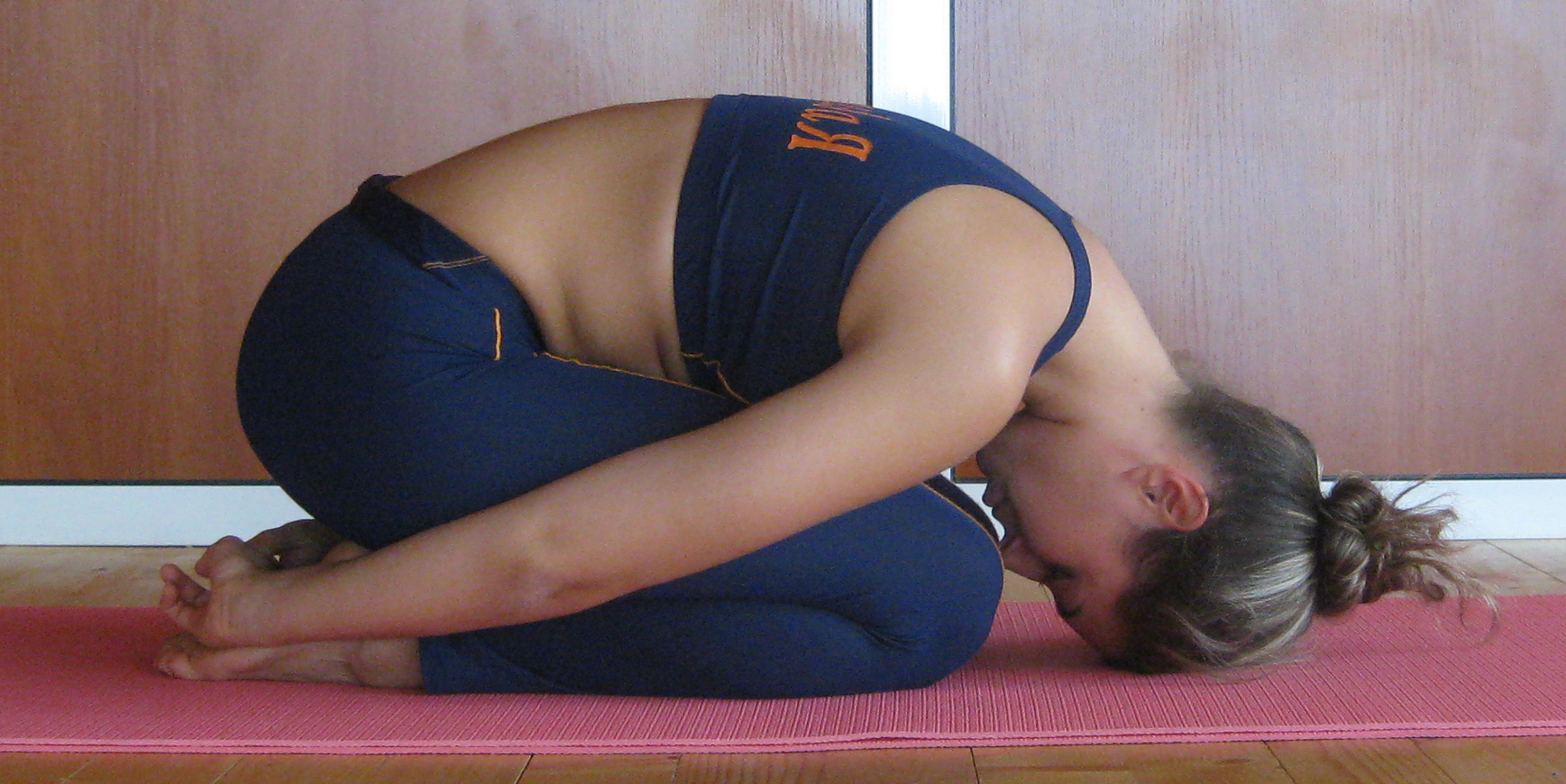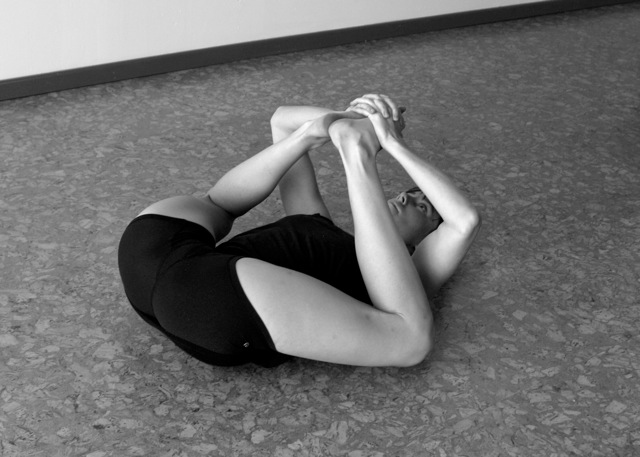Balasana on:
[Wikipedia]
[Google]
[Amazon]
 Bālāsana ( sa, बालासन) or Child Pose, is a kneeling asana in modern
Bālāsana ( sa, बालासन) or Child Pose, is a kneeling asana in modern

 If need be, and during pregnancy, the knees can be spread. The arms may be stretched forward in front of the head. If there is discomfort in the neck and shoulders, a rolled blanket may be placed on the backs of the lower legs, and the forearms can be stacked and the forehead rested on them.
Ananda Balasana or "Happy Baby Pose" is an inverted form of Child's Pose; it has the body on the back, the thighs alongside the body, the knees bent and the hands grasping the toes.
Uttana Shishosana or "Extended Puppy Pose" stretches forwards from all fours until the forearms and forehead are resting on the floor and the thighs are vertical, giving a pose intermediate between Balasana and Adho Mukha Shvanasana (Downward Dog Pose).
Shasangasana (शसांगासन) or "Rabbit Pose", practised in
If need be, and during pregnancy, the knees can be spread. The arms may be stretched forward in front of the head. If there is discomfort in the neck and shoulders, a rolled blanket may be placed on the backs of the lower legs, and the forearms can be stacked and the forehead rested on them.
Ananda Balasana or "Happy Baby Pose" is an inverted form of Child's Pose; it has the body on the back, the thighs alongside the body, the knees bent and the hands grasping the toes.
Uttana Shishosana or "Extended Puppy Pose" stretches forwards from all fours until the forearms and forehead are resting on the floor and the thighs are vertical, giving a pose intermediate between Balasana and Adho Mukha Shvanasana (Downward Dog Pose).
Shasangasana (शसांगासन) or "Rabbit Pose", practised in
Yoga Journal
Photo and instructions {{DEFAULTSORT:Balasana Buddhist meditation Sitting asanas Kneeling asanas Hip-opening asanas
yoga as exercise
Yoga as exercise is a physical activity consisting mainly of asana, postures, often connected by vinyasa, flowing sequences, sometimes accompanied by pranayama, breathing exercises, and frequently ending with savasana, relaxation lying down or ...
. Balasana is a counter asana for various asanas and is usually practiced before and after Sirsasana.
Etymology and origins
The name comes from the Sanskrit words बाल ''bala'', "child" and आसन ''āsana'', "posture" or "seat". Balasana is not described until the 20th century; a similar pose appears in Niels Bukh's 1924 ''Primary Gymnastics''. Ananda Balasana is illustrated as Kandukasana (Ball Pose) in the 19th century ''Sritattvanidhi
The ''Sritattvanidhi'' (, "The Illustrious Treasure of Realities") is a treatise written in the 19th century in Karnataka on the iconography and iconometry of divine figures in South India. One of its sections includes instructions for, and ill ...
''.
Description
From a kneeling position, bring the forehead to the floor and relax the arms alongside the body, palms upwards.Variations

 If need be, and during pregnancy, the knees can be spread. The arms may be stretched forward in front of the head. If there is discomfort in the neck and shoulders, a rolled blanket may be placed on the backs of the lower legs, and the forearms can be stacked and the forehead rested on them.
Ananda Balasana or "Happy Baby Pose" is an inverted form of Child's Pose; it has the body on the back, the thighs alongside the body, the knees bent and the hands grasping the toes.
Uttana Shishosana or "Extended Puppy Pose" stretches forwards from all fours until the forearms and forehead are resting on the floor and the thighs are vertical, giving a pose intermediate between Balasana and Adho Mukha Shvanasana (Downward Dog Pose).
Shasangasana (शसांगासन) or "Rabbit Pose", practised in
If need be, and during pregnancy, the knees can be spread. The arms may be stretched forward in front of the head. If there is discomfort in the neck and shoulders, a rolled blanket may be placed on the backs of the lower legs, and the forearms can be stacked and the forehead rested on them.
Ananda Balasana or "Happy Baby Pose" is an inverted form of Child's Pose; it has the body on the back, the thighs alongside the body, the knees bent and the hands grasping the toes.
Uttana Shishosana or "Extended Puppy Pose" stretches forwards from all fours until the forearms and forehead are resting on the floor and the thighs are vertical, giving a pose intermediate between Balasana and Adho Mukha Shvanasana (Downward Dog Pose).
Shasangasana (शसांगासन) or "Rabbit Pose", practised in Bikram Yoga
Bikram Yoga is a system of hot yoga, a type of yoga as exercise, devised by Bikram Choudhury and based on the teachings of B. C. Ghosh, that became popular in the early 1970s. Classes consist of a fixed sequence of 26 postures, practised in a r ...
, has the tailbone lifted until the thighs are vertical and the head and arms point back towards the feet, creating an intense flexion of the spine.
Sucirandhrasana (सुचिरंध्रासन), "Eye of the Needle", or "Thread the Needle Pose", also called Parsva Balasana, has the head and feet as in Balasana, the knees bent, the hips raised, and one shoulder on the floor, with the arm on that side stretched out in front of the face at right angles to the body along the floor. The other arm may be stretched forwards over the head, folded behind the back, or stretched straight up into the air.
See also
*List of asanas
An asana is a body posture, used in both medieval hatha yoga and modern yoga. The term is derived from the Sanskrit word for 'seat'. While many of the oldest mentioned asanas are indeed seated postures for meditation, asanas may be standing, se ...
References
External links
*Yoga Journal
Photo and instructions {{DEFAULTSORT:Balasana Buddhist meditation Sitting asanas Kneeling asanas Hip-opening asanas